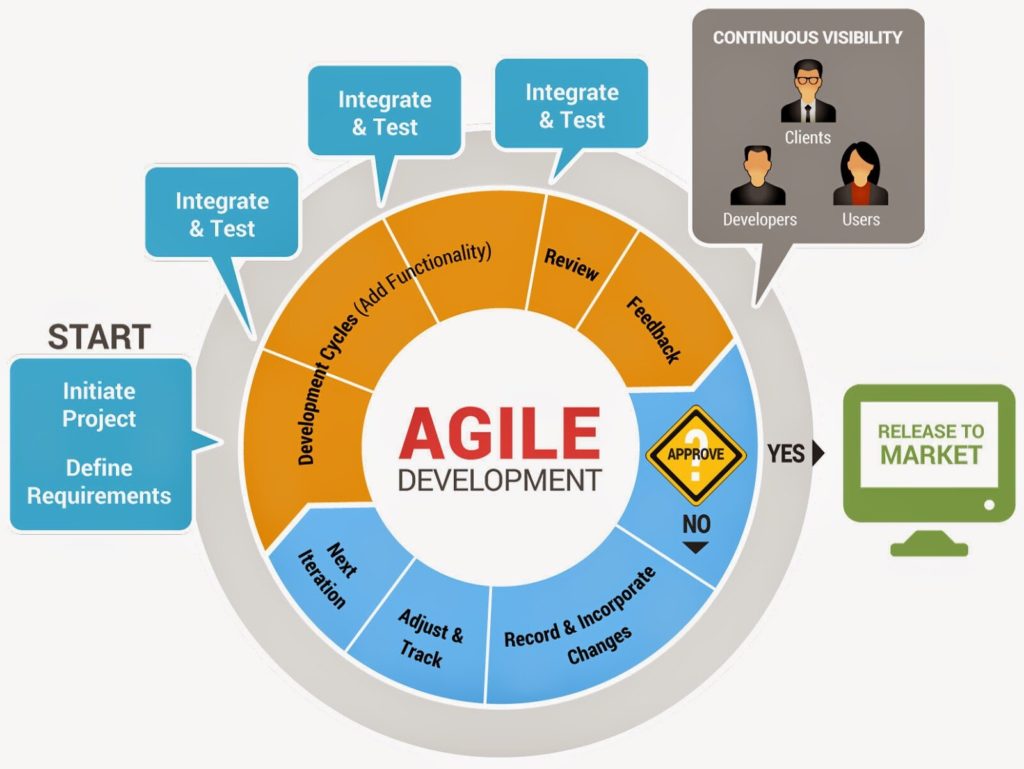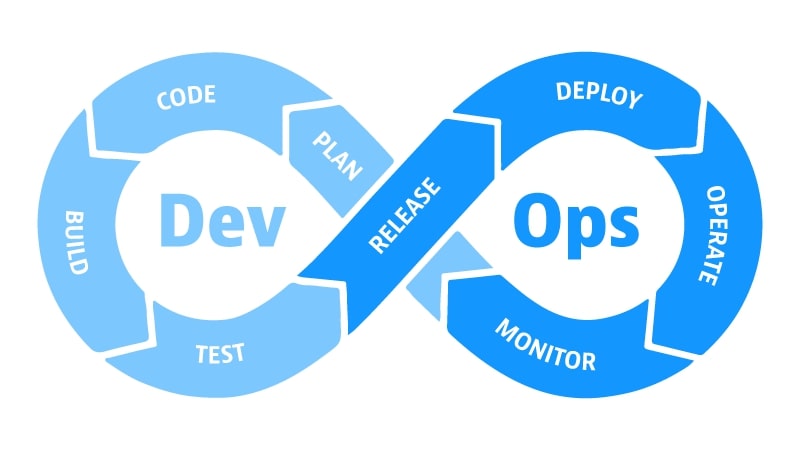Agile and DevOps are two new ways of managing complex projects in the product development world. Both focus on cutting waste and increasing collaboration between teams.
The use of the agile methodology has become widespread since the early 2000s. However, since then, companies continue to overlook the requirements and processes of the operations team in many agile environments during the development and deployment of solutions.
DevOps focuses on aligning development and operations teams to replace the gaps in agile practices.
How do DevOps and agile co-exist now?
In this article, we dive into that and more.
What is Agile?
The agile software development and project management approach use inter-team working, customer feedback, and regular iteration releases to react to changes in customer requirements and the marketplace with minimal disruption.

Credits: Educore
Agile teams break down the product development into small tasks, often known as sprints, through close liaison with key stakeholders. The team adopts changes as the project progresses. They also release new versions of the product faster and with more regularity than those developed through the linear waterfall method.
The most significant advantage of this iterative development approach is that if the product does not meet the customer’s needs, the team gets the chance to come up with solutions to the problems as they crop up.
Several different agile methodologies evolved and now constitute the Agile Manifesto. The four core values of the manifesto give way to the 12 principles of agile working.
The four core values are:
- Individuals and interactions are better than processes and tools: The agile manifesto emphasizes the importance of people over weighty and inflexible processes. The key to success is ensuring the right mix of people in the team and encouraging clear and open communication and collaboration.
- Working software is better than process documentation: Some documentation is necessary to ease the onboarding of a new team member.
- Customer collaboration is better than contract negotiation: Companies need contracts when developing any new product. However, if they are too inflexible, there is a danger of delivering a product that veers from the contract specification. The agile manifesto advocates continuous development and customer collaboration as the best way to ensure successful project delivery.
- Responding to change is better than following a plan. The agile manifesto embraces the idea of providing teams with the flexibility and freedom to make changes and respond to the changing needs of the customer to produce the best possible product. As the name suggests, an agile team has an innate ability to shift priorities as required rather than sticking to a rigid plan.
What is DevOps?
DevOps incorporates many of the principles of agile methodology, focusing on collaboration between the development and operations teams. However, while the development, final testing, and deployment process are similar to agile development, operations are integral to DevOps.

Credits: Dynatrace
The underlying target of DevOps is to integrate developers who build solutions with operations teams who run and support the solutions before, during, and after the team has launched those solutions.
Before the genesis of the DevOps approach, the two teams co-existed with a silo mentality. The operations team had limited visibility of the development process, leading to a disconnect regarding the solution’s running and maintenance.
DevOps focuses on bringing the operations and development teams close together throughout a product or software development project’s entire development, deployment, and management.
One accepted framework in the DevOps world is “Three Ways”. Another is “CALMS.”
Three Ways
The DevOps Three Ways framework consists of the following:
- Systems thinking: An understanding that applications and products are complex systems.
- Amplify feedback: Improving communication between the operations and development teams in both directions.
- Culture change: Encouraging an environment of continuous integration, experimentation, and learning.
CALMS
“CALMS” is an acronym for Culture, Automation, Lean, Measurement, and Sharing.
- Culture: Promotes a cultural shift where the development team works in close alignment with operations teams.
- Automation: Encourages automation of manual processes to increase speed and improve quality. An example of this is automated testing.
- Lean: Instigates a continuous improvement process and using failure as a springboard for learning.
- Measurement: This consists of using results and metrics to improve processes.
- Sharing: Emphasizes the benefits of sharing knowledge and best practices with other DevOps team members.
Do Agile and DevOps Work Together?
DevOps is an evolutionary development of an agile methodology to replace the missing piece of the agile development process. It takes the innovative steps in an agile method and applies them to the operational team to improve operational and business readiness.
For example, agile process documentation refers to continuous delivery. However, with delivery reliant on the operations team, DevOps closes the circle of the delivery pipeline.
Feedback improvement depends on enhanced communication within individual teams and across multiple groups. Agile methodology helps facilitate this improved communication through practices such as stand-ups every day, planning meetings, and retrospective lessons learned sessions.
Agile vs. DevOps Similarities
The agile and DevOps approaches share similar focuses and end goals. They focus on speed, efficiency, and quality of delivery throughout the product lifecycle.
Unlike waterfall processes, the agile methodology and DevOps approach emphasize the benefits of focusing on automation and collaboration rather than comprehensive documentation of processes, which is time-consuming and inflexible. In addition, where risk increases as a waterfall project progress, risk levels decrease in a DevOps and agile arena because of the ability to react to changes as required.
Agile or DevOps approaches empower companies to respond to changing business needs as challenges arise. This brings tighter ownership of a business’ projects and less likelihood of failure.
Agile vs. DevOps Differences
The agile methodology brings an iterative approach to product and software development, with rapid releases of new features or products. This approach encourages collaboration between developers and product managers.
DevOps, however, removes the need for regular releases through the closer collaboration between the development and operations teams. Their focus is more on maintenance and delivery.
To achieve this, the DevOps approach relies on testing teams continuing to work on honing their delivery, while the agile method focuses on continuous integration and changes as required.
As a result, the size of DevOps teams is much larger than those of agile teams.
Agile vs. DevOps Comparison
Understanding the nuances between the two approaches is essential to making the best-informed decision about whether the agile or DevOps method is the best fit.
Use
Agile principles are an ideal tool to manage complex projects, while DevOps focuses more on the end-to-end engineering process, from beginning to delivery.
Focus
The agile development environment welcomes and encourages mid-project changes to improve product quality. DevOps works to avoid customer-driven changes throughout the project by ongoing testing and continuous development.
Delivery
DevOps projects look to achieve continuous deployment, updates every day or every few hours that they then test, with feedback returning to the team members to allow for ongoing development. Agile projects release new features or fixes after each sprint throughout the project lifecycle.
Documentation
While both approaches favor low levels of documentation, the agile approach favors a low level of process documentation to increase flexibility in the agile development process. DevOps has a higher level of documentation to allow the development and operation teams to build efficient collaboration. However, the focus is on communication over paperwork.
Quality and Risk
DevOps and Agile approaches are similar in that risk reduces as the project progresses while the quality increases. The processes for each method differ, with the product quality improvement during an agile project after each sprint. In contrast, in the DevOps environment, the quality improves with reduced risk through constant testing and effective collaboration between the development and operations teams.
Feedback
The feedback loop differs between both approaches. In an agile development process, the team incorporates customer feedback into the development cycle after each sprint to make changes and tweaks to the product. DevOps feedback is contingent on communication between the development and operations team members serving as a catalyst to accelerate delivery and improve product quality.
Combining Agile and DevOps
Creating an environment where Agile and DevOps work in tandem produces several benefits. These include rapid deployment, excellent end-user satisfaction, and high levels of collaboration.
However, merging the two approaches requires changes to existing processes and work cultures:
Understanding
Agile focuses on team members’ solid understanding of other people’s tasks. This is important for project managers and product owners to enable them to manage a project to completion. They must know every step required in delivering a product to ensure the deployment of a product that meets quality demands.
Collaboration
DevOps practices rely on the collaboration of the development and operation teams. For this to happen, each team member in operations needs to understand all aspects of development cycles, while development team members require knowledge of the ops process to increase internal team working.
DevOps Presence in Sprints
The DevOps team must integrate into how an agile team works to maximize efficiency. The entire DevOps team must include themselves throughout a sprint, including during planning, everyday stand-up meetings, and lessons learned retrospective sessions to share best practices and learnings from mistakes.
Automation of Processes
Automation is vital to DevOps practices and must include product planning and other agile methodologies. This includes using Artificial Intelligence (AI) technologies to automate manual processes in the software development and product development environments.
Measuring Success
End-to-end development is another essential part of DevOps, which relies on KPIs and metrics to measure and assess success. Trams must respect this process when merging agile and DevOps to ensure high-quality product production and rapid deployment.
Agile vs DevOps: Key Takeaways
Instead of wondering whether agile and DevOps co-exist with success in the same space, such are the benefits of merging the two methodologies that teams must make every effort to combine the two.
The DevOps culture embeds into the agile framework while the two approaches use similar and equal skills between interdependent teams.
While the iterative approach favored by the agile methodology clashes with the continuous delivery ethos of DevOps, making an effort to combine DevOps and agile fills the missing element of agile, which overlooks development and operations.
Bringing DevOps and agile together is one of the best ways of ensuring the delivery of quality products at low risk while keeping the customer at the very heart of the product development lifecycle.